Taking a road trip in Turkey is always a good idea. We loved our experiences and have written this guide to help you navigate Turkey by car to see the most picturesque villages.
This in-depth guide also covers road rules in Turkey, car hire company suggestions, and how to stay safe on the roads.
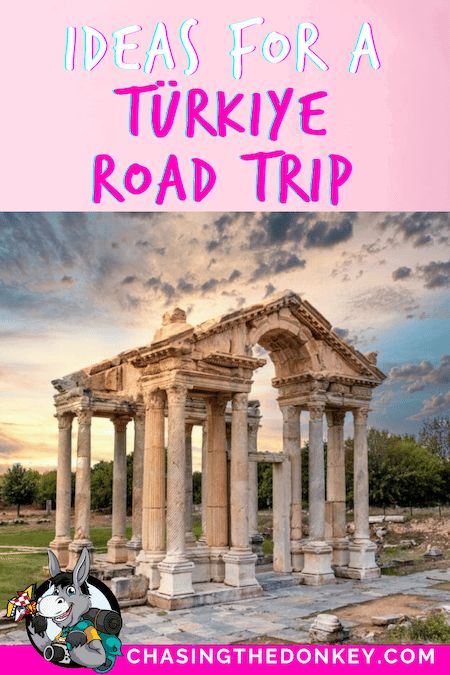
What better way to see passing scenery and stop off to experience local cuisine and traditions than to drive at your own pace? Sure, you’re passing by and not staying in one particular place, but you don’t need to base yourself somewhere for days to say you’ve experienced it.
Türkiye is a fantastic choice for a road trip. Turkey is far bigger than most people expect, and there are around 8000 km (5000 miles) of coastline to explore; that’s not even touching the interior and the beautiful countryside and mountains.
Turkey is the ideal spot if you want to explore to your heart’s content.
Of course, you need to know a bit of information before you go on a road trip in Türkiye, and you also need to know the best road trip routes in Turkey that you can take. Below, we’ve covered all that and more.
Skip Ahead To My Advice Here!
Things To Know Before Taking A Road Trip In Türkiye
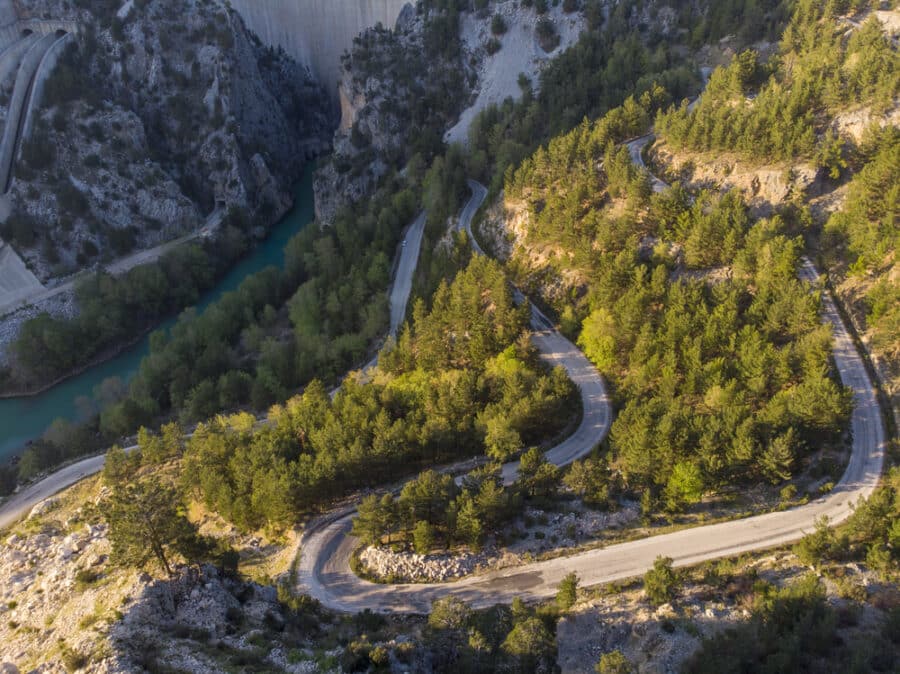
Turkey’s roads are relatively easy to navigate, especially between large towns and cities. The major highways and freeways are all well-signposted, and the quality of the roads are all excellent.
However, there are some tolls you need to know about, especially if you’re heading up to Istanbul. These are paid by a specific system that all hire cars in Türkiye will already have set up for the hire car. This HGS or OGS onboard unit will log payment and deduct it from your debit or credit card.
With our car hire in Turkey, we discovered the charges just 48 hours after returning the car. The toll fees were deducted from the initial downpayment we made on the credit card (mandatory), and the rest of the funds were refunded to us automatically.
OGS & HGS
- OGS: A slow-speed automatic toll system in which a transponder pays the toll as you drive through a toll gate at slower speeds
- HGS: The high-speed system allows you to pass through the toll area at highway speeds
Toll Gates & Fees And Your Own Vehicle

If you’re driving your car in Tukey and don’t have this system on board, YOU HAVE TO REGISTER FOR ONE, as there are no toll booths in Turkey – they have all been removed. The fines for not paying the toll can be huge.
You can stop at the first PTT branch or Shell Petrol Station you see in Turkey and give them a photocopy of your auto registration and passport, pay a fee to be enrolled in the HGS system, and receive an HGS registration sticker or card.
The HGS system uses these to identify you, so make sure they are displayed on your front windshield. You will also be asked to provide an initial sum of Turkish Lira to be added to get you started.
Warning: You cannot pay for Turkish toll roads on any website. It must be paid at a PTT branch or Shell station. Any websites or blogs claiming to credit your HGS account are fake, and you will lose your money.
Is Driving In Tukey Hard

It’s not difficult to drive in Turkey, although you must be cautious and take your time in and around cities. Some people tend to go somewhat erratically and fast, especially in Istanbul!
The traffic in Türkiye’s largest city is also insane, and, in all honesty, it’s just not worth attempting to drive in Istanbul. The public transport system is fantastic and will save you a world of stress.
We found driving in Denizli, Pamukkale, Selcuk, and Izmir to be problem-free and found trying to find parking to be the only downside.
- In Türkiye, you drive on the right-hand side of the road
- Seat belts are compulsory – for both drivers and passengers
- If you’re driving a motorbike, you must wear a helmet at all times
- International drivers should have their driving license on them at all times – which includes an international driving license, insurance papers, passport, and any visa papers with them at all times
- Speed limits are 50km/h in cities, 110km/h on country roads, and 120km/h on highways – be warmed speed cameras are in use!
How Difficult Is It To Rent A Car In Turkey

Renting a car in Turkey is straightforward; you will find all the major car rental companies at international airports. Some will ask you to show your flight ticket when you hire a car, and you will be asked to give your credit card details to secure the booking.
You will need to show a valid driver’s license and your passport. Costs vary from company to company, but you can easily shop around online and find a good deal. You can also pick your car up from one city and drop it off in another if you book with a large rental company. Remember that you must drop the car off with a full fuel tank.
We were asked to leave €300 as a security deposit on the credit card to cover the toll roads and any possible damage. The remaining funds were refunded to us 48 hours after returning the car.
Best Road Trips In Türkiye
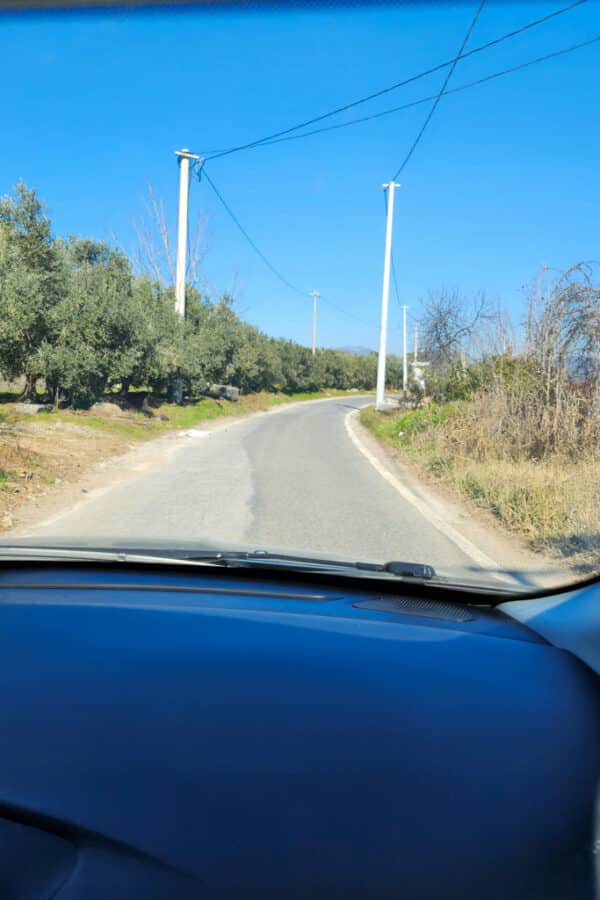
The beauty of taking a road trip in Turkey is that you can be as fast or leisurely as you like. But, of course, we suggest you take your time and immerse yourself in everything you can see and taste.
Here are a few Turkey road trip ideas you might like to consider. Remember, they can be for three days, five days, seven days, or even more if you choose. There’s plenty of scope for layovers on all these road trip suggestions! It’s up to you to select your stop-offs and how long you want to stay in a place to explore them.
Road Trip From Istanbul To Izmir – 880km (545 miles)
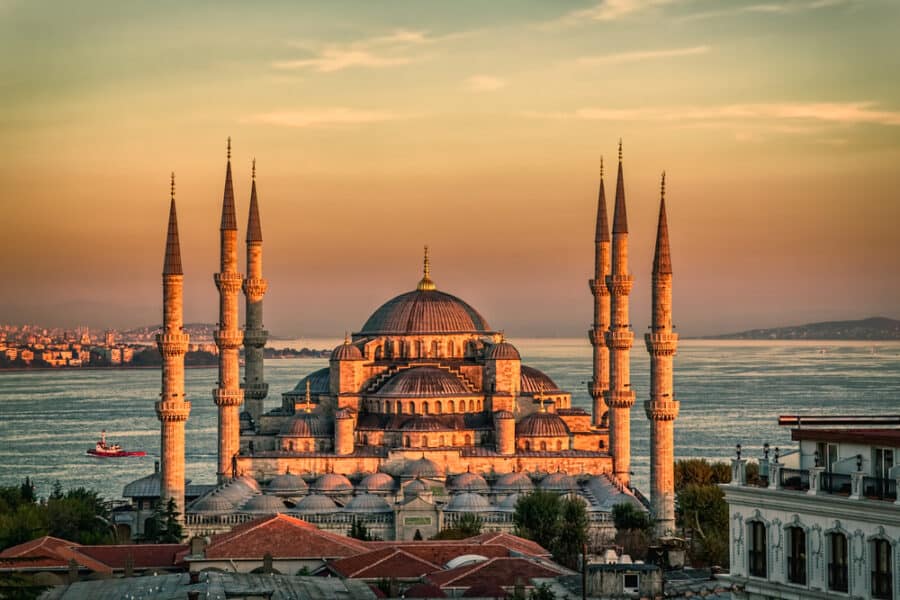
There is a lot to see here. Of course, if you drive straight through, it will only take you a matter of hours – around 5 hours in general, and there are some toll roads along the way. However, there are plenty of things to see, and you should take your time and let this part of your Türkiye road trip be around 3-5 days.
Canakkale is a definite must-stop along the way, and although you’ll need to take a slight detour from Istanbul (to the west), it should only take you an hour out of your way. This is where you can see the horse from the Troy film starring Eric Bana and Brad Pitt, but it’s also where the famous battle occurred.
As you head down the country, you can stop in Bursa, the ski resort of Uludag, Baliksehir, and Tekirdag, which has some wonderful wineries to check out. Make a stop in Bergama and Ayvalik before heading down to Izmir. Once there, finish your trip with a visit to the ancient city of Ephesus.

Dalaman To Antalya Road Trip (Lycian Coast) – 337km (209 miles)

This is a short road trip, but you can take your time and really enjoy the stunning coastal views. Many people walk this route, part of the Lycian Way, but driving is just as fun if you want to save your feet!
The road that runs between Patara and Antalya is lovely, with a winding route that takes you right to the edge of soaring cliffs. You can stop at many beautiful beaches along the way and make Olu Deniz one of your stops – the Blue Lagoon is famous worldwide, and this is a top spot on your Türkiye road trip for parasailing.
Be sure to visit Gocek and check out the glittering harbor of expensive yachts before moving on to Fethiye and its beautiful beaches and chilled-out vibe. Kayakoy is another famous site, a ghost village that once belonged to the Ancient Greeks and is now totally abandoned – nobody knows why.
The ancient former capital of the Lycian civilization is a must-visit – Xanthos, Letoon, and Pinra. Kas has some of the most beautiful beaches before heading to stunning Olympia and ending up in Antalya, a fantastic city with beaches, food, and nightlife.
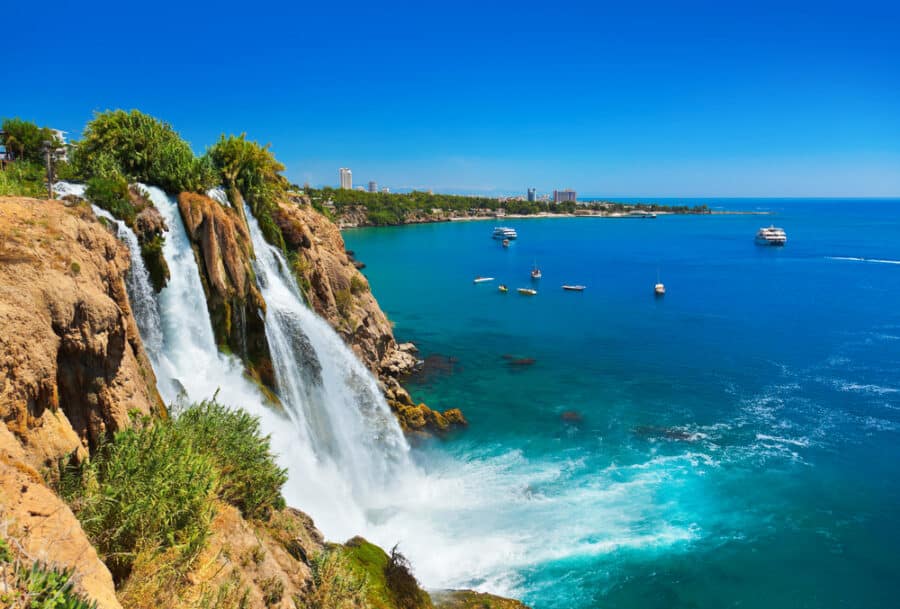
Road Trip From Ankara To Konya – 692km (430 miles)

Ankara is Turkey’s capital city and is a beautiful spot to begin your new road trip. Make sure you visit the Museum of Anatolian Civilizations before heading to the mausoleum of Mustafa Kemal Ataturk. You should then prioritize Hattusa, an old capital of the Hittite Kingdom.
Then, head to Cappadocia and make sure you spend at least a couple of days here – you could even have a ride in a hot air balloon! There are some great hotels in Goreme, and you can also stay in a cave hotel.
Once you arrive in Konya, spend some time exploring history, but also make sure you try as much local cuisine as possible.
You should 100% head to traditional ocakbasi restaurants and seafood spots to enjoy some of the finest Turkish food you’ll ever taste.

Trabzon To Kars Road Trip – 640km (397 miles)
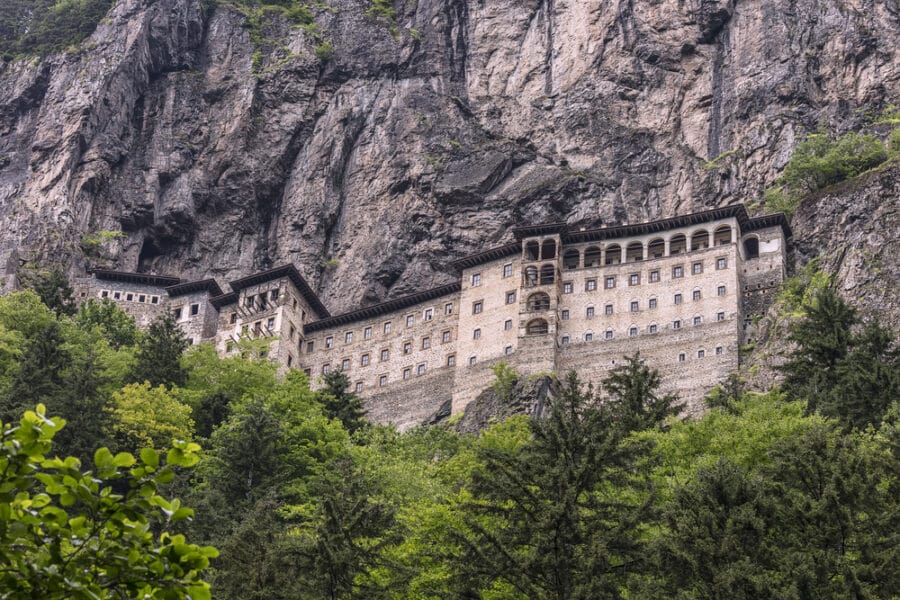
This is a beautiful road trip with fantastic scenery, but it is one that should only be attempted by those who feel comfortable driving in Türkiye. The roads are mountainous and can be hazardous during the winter time. Despite that, you will be rewarded with rugged landscapes and unique photo opportunities.
Trabzon is your starting point; be sure to soak up all the culture and cuisine before you leave. Then, head to Sumela Monastery, a 4th-century monastery high in the mountains.
Your next stop is Erzurum, which is an excellent spot for winter sports, before heading over to Kars with its fantastic architecture. Make sure you spend some time in Ani, which used to be a part of Armenia and has plenty of old architecture to check out.

Road Trip Istanbul To Samsun – 1516km (941 miles)
Dolmabahce Palace on the banks of the Bosphorus in Istanbul. This is undoubtedly a long road trip, and you should take your time to soak up the stunning scenery of the Black Sea coastline. However, remember that during the winter months, in particular, it can rain quite a lot along this part of the country, and it indeed snows – that only makes for even better photographs!
Be sure to stop at Lake Sapanca and the small villages of Mudurnu and Goynuk. You’ll be able to check out old Ottoman architecture, and it’s a great spot to stay overnight or for a day or two if you want to enjoy the peace and quiet.
It would be best to make time for stops in Yenice Forest and Lake Abant, perfect for countryside chills, and explore Amasra and its old castle. Sinop is an excellent stop with fantastic food before checking out Tokat and then moving on to the Black Sea coastal resort of Samsun.
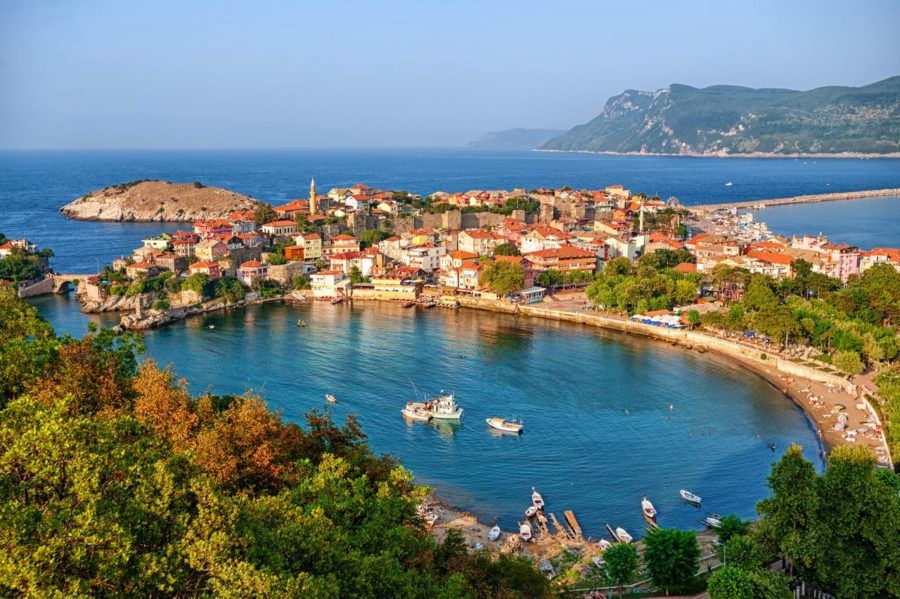
Brands We Use And Trust
Do You Need An International Driving License In Turkey
Yes, if you are a foreign national planning to drive in Turkey, having an International Driving Permit (IDP) and your home country’s driving license is recommended.
While many car rental agencies and local authorities accept English-language licenses, an IDP ensures there are no language barriers. The IDP is valid for a limited period, after which individuals planning to reside longer may need to obtain a Turkish driving license.
Drinking & Driving In Turkey

You are on vacation and in a rental car, so don’t. That said.
Drink driving, also known as driving under the influence (DUI) or driving while intoxicated (DWI), is a serious offense in many countries, including Turkey. Turkey has stringent rules and penalties associated with drunk driving to ensure the safety of all road users.
Blood Alcohol Concentration (BAC) Limit:
- For private car drivers, the BAC limit is 0.05 grams per deciliter or 0.05%. This means having a BAC level above this threshold while driving is illegal
- For professional drivers, such as bus and truck drivers, the BAC limit is set at 0.00%. Essentially, they are not allowed to have any alcohol in their system when driving.
Penalties:
The penalties for exceeding the allowed BAC limit can range from heavy fines to imprisonment, depending on the level of intoxication and if it’s a repeated offense.
First-time offenders usually face a driving ban for a specified period and a fine. The duration of the ban and the fine amount may increase with the level of intoxication. The offender might face imprisonment for repeated offenses or extremely high BAC levels.
In the case of an accident caused by drunk driving that results in injury or death, the penalties are significantly more severe – who wants to go to jail in Turkey? Not me or you, I bet, so stay safe and avoid drinking in Turkey.
Road Signs In Turkey
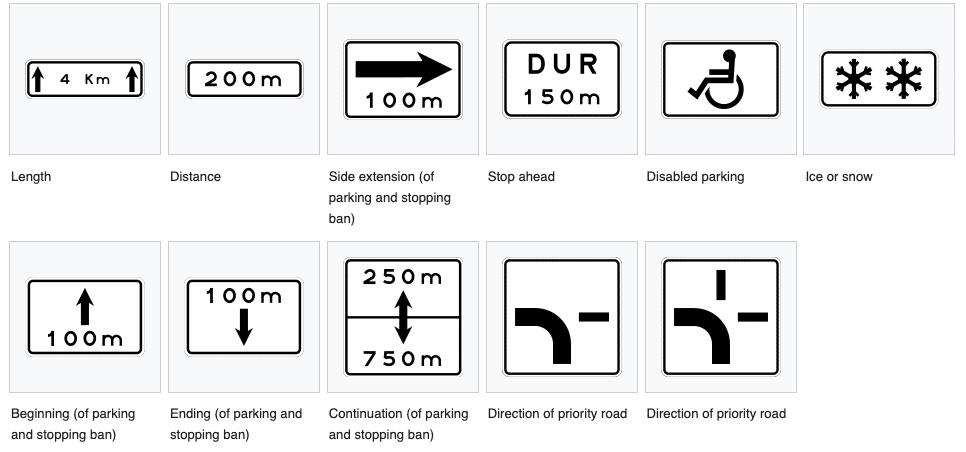
Major road signs in Turkey follow international conventions, particularly those outlined in the Vienna Convention on Road Signs and Signals. They are crucial for maintaining safety and order on the roads.
Shapes and Colors
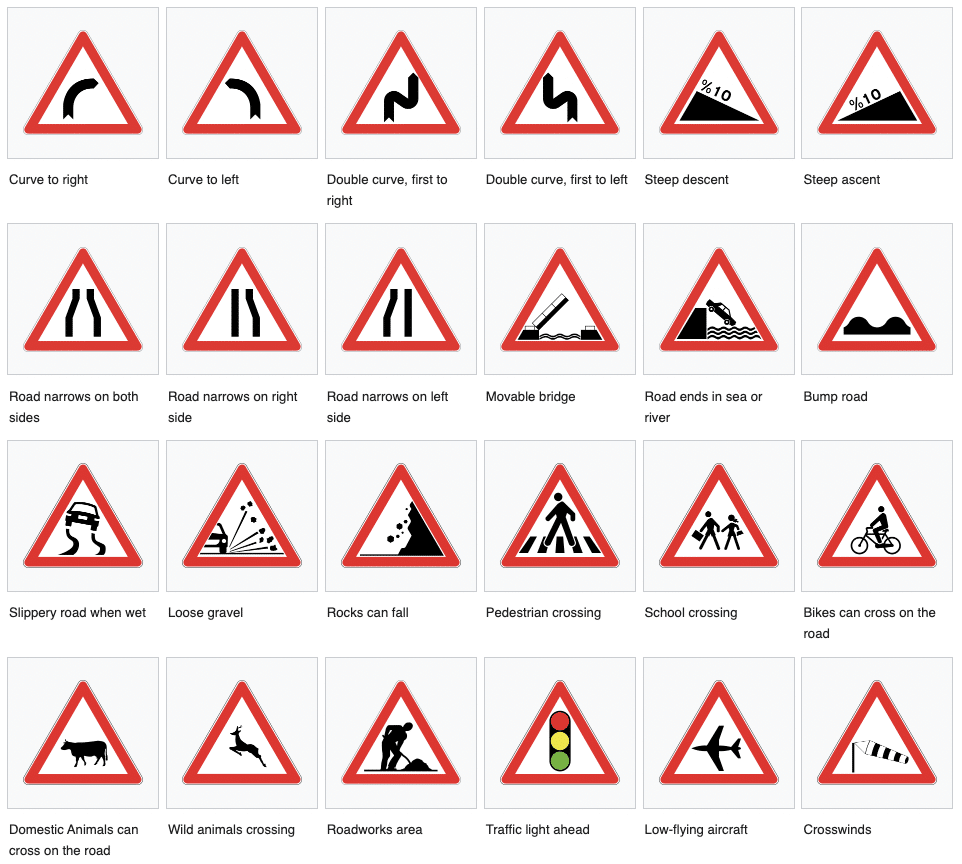
- Circular: Generally gives orders (e.g., speed limits)
- Triangle: Warns of possible dangers ahead (e.g., curve, junction, or pedestrian crossing)
- Rectangular: Provides information or directions (e.g., distances to destinations, parking areas, or bus stops)
Types of Traffic Signs
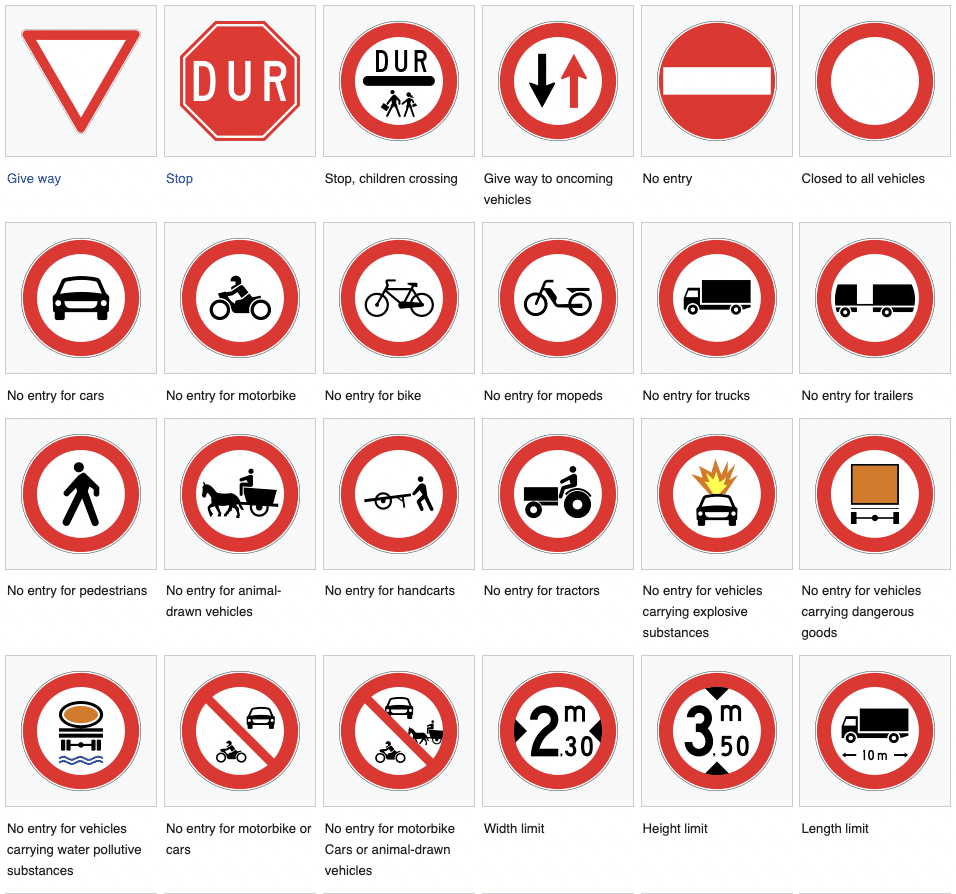
- Regulatory Signs: These are usually circular and include:
- Red Circle: Prohibits certain actions, like “No Parking” or speed limits
- Blue Circle: Mandates certain actions, such as “Turn Right Only.”
- Warning Signs: These are triangular with a red border and warn of upcoming conditions like curves, intersections, pedestrian crossings, or schools
- Information Signs: Rectangular signs that provide information such as directions, distances, or facilities nearby
- Temporary Signs: Used during construction or when there are temporary changes to the road. They usually have a yellow background
- Supplementary Plates: These are additional signs placed below the main sign to provide more specific information or clarity, such as distance to the hazard or specifics of the regulation
Common Symbols and Their Meanings
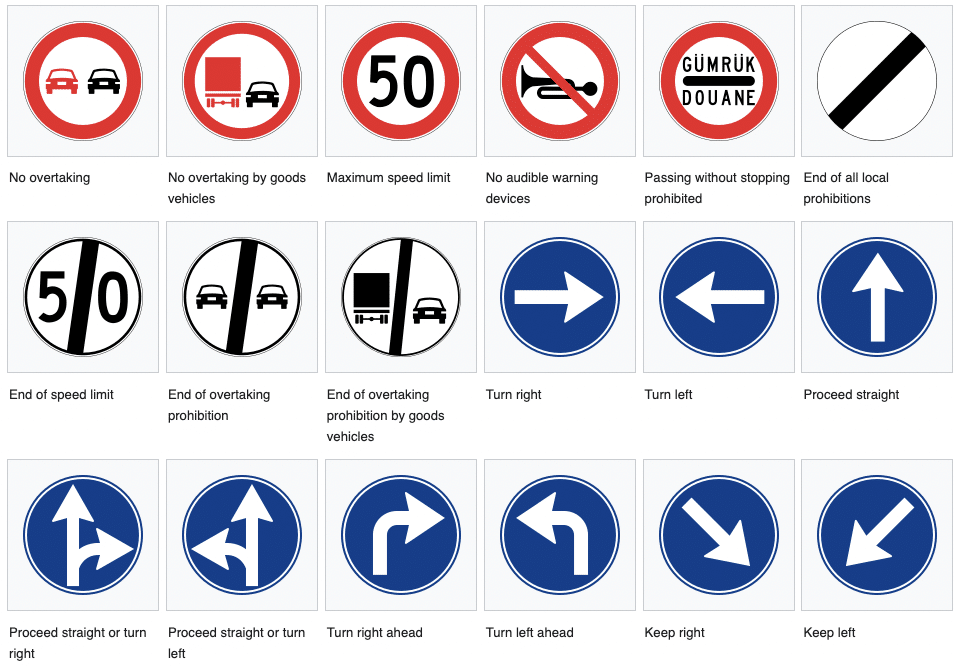
- Pedestrian Crossing: A pedestrian silhouette
- No Parking: A blue circle with a red border and a black car with a red line across it
- Speed Limit: A number within a red circle indicates the maximum speed in kilometers per hour (km/h)
- Junction: Two or three roads intersecting, shown in simplified form
- Roundabout: A circular intersection where traffic flows continuously in one direction
Language
While international symbols are prevalent on Turkish road signs, written information, such as place names or directions, is in Turkish. However, major tourist areas or highways may have signs in both Turkish and English.
Touristic and Historical Places
Brown signs often indicate historical sites or places of tourist interest.
Parking
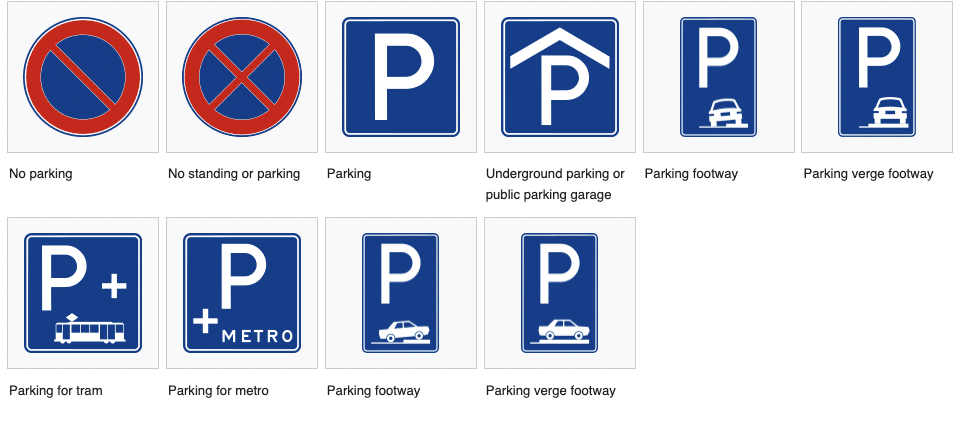
Blue square or rectangular signs with a white “P” signify parking. Restrictions or specifics about the parking might be detailed on supplementary plates.
Traffic Lights In Turkey
Traffic lights in Turkey generally follow international standards, but there might be some specific practices or features to be aware of.
Here’s an overview of all of the traffic lights in Turkey.
Standard Traffic Lights
- Red: Indicates “stop.” Vehicles must stop before the white stop line on the road
- Yellow/Amber: Used as a transition between red and green or green and red. If it lights up after the red, it’s an indication that the green light will come on next
- Green: Indicates “go,” but always proceed with caution, especially when turning (see next section for why)
Pedestrian Traffic Lights
These are typically near crosswalks. A standing human figure in red means “do not cross,” while a walking human figure in green means it’s safe to cross. Some areas might have countdown timers indicating how much time is left to safely cross the street.
Flashing Amber Light
If you encounter a flashing yellow light at an intersection, it typically means you should proceed with caution. It’s often used during times when traffic is light or during the malfunctioning of standard traffic lights.
Turning
- In many intersections, especially in cities, you might see dedicated arrow signals for turning left or right. A green arrow indicates it’s safe to turn in the direction the arrow points
- If there’s no arrow and you have a green light, always yield to oncoming traffic when turning left
Actuated Signals
In some parts of Turkey, traffic lights, especially those at pedestrian crossings, might be actuated, meaning they change only when a pedestrian presses a button.
‘No Turn on Red’ Sign
Unlike some countries where turning right on red after stopping (if the way is clear) is permissible, in Turkey, you must wait for the green light to turn unless a sign indicates explicitly otherwise.
Bicycle Traffic Lights
In areas with bicycle lanes, there might be dedicated traffic lights for cyclists. They work similarly to pedestrian lights, with symbols representing a bicycle.
Public Transport Lights
In cities like Istanbul, where there’s a tram system, there might be specific traffic lights for trams. Always be cautious and yield to trams, as they have the right of way when their signal is green.
What’s the quality of the main roads and major roads in Turkey?
The main roads and major roads in Turkey, especially the main highways, are of international standard and are well-maintained. However, be cautious in mountainous areas where the road surfaces can be tricky.
How do Turkish drivers compare to those in European countries?
Turkish drivers can be aggressive compared to drivers in some European countries. It’s essential to be alert, especially in big cities and large cities, where traffic jams during peak times are common.
Can I use Google Maps for navigation in urban and rural areas of Turkey?
Yes, Google Maps works well in both urban areas and rural areas of Turkey. However, always consult local people for a little bit more insight on less-traveled routes.
Are car rentals easily available in major cities?
Absolutely! Major cities offer various car rentals, including international and local agencies. Discover cars with the best deals by comparing prices and checking reviews.
I’ve heard about the green card for driving in Turkey. What is it?
The green card is an international insurance certificate recognized in many countries. If you’re coming from certain European countries, it might be a legal requirement to have one when driving in Turkey.
How common are dual carriageways in Turkey?
Dual carriageways, or two-lane highways, are prevalent on the road network, especially between major cities. They help facilitate smoother and faster traffic flow.
If I’m stopped by a police officer or traffic police, what should I have ready?
Always have your home country driving license, International Driving Permit, vehicle registration, insurance documents, and, if applicable, your green card. Remember, using a cell phone without a hands-free electronic device while driving can lead to being stopped by traffic police.
Is there a legal requirement for certain items to be present in cars in Turkey?
Yes, having a first aid kit, warning triangle, and reflective vest in your vehicle is legally required. If you’re traveling with children, ensure you have the correct child safety seats: a rear-facing seat for infants and appropriate boosters for older children.
What are the rules regarding fuel stations and gas stations in Turkey?
Fuel stations and gas stations are plentiful, especially along main highways. Many service stations in urban areas are open 24/7. It’s advisable to refuel in rural areas when you’re at half tank as stations can be sporadic.
How does parking work in Turkey’s urban areas?
Parking can be challenging in most urban areas, especially in big cities. Look for parking lots or areas with parking meters. These meters, or ticket machines, are easy to use. However, free parking spaces can be limited during peak times.
What side of the road do Turkish people drive on?
In Turkey, people drive on the right side of the road, similar to many European countries.
Is there a minimum age for driving in Turkey?
Yes, the minimum age to drive a car in Turkey is 18. However, many companies might have a higher age requirement for car rentals.
Are there any police checkpoints or high-speed toll system checkpoints on the roads?
Yes, there are periodic police checkpoints for security and random checks. As for tolls, some major roads and bridges operate on a high-speed toll system. Ensure your rental
You now have your road trip in Turkey guide in hand; tell us which stops you will make on your Turkish road trip.
- The Do’s And Don’ts Of Visiting Turkey
- Fethiye To Marmaris Sea Bus Services
- Best Places To Visit In Turkey For Every Type Of Traveler
- How To Get From Istanbul To Cappadocia
- Best Nightlife In Istanbul
- Day Trips To Take From Istanbul
- Greek Island Day Trip From Southern Turkey
- How To Haggle In Turkey
- Best Beaches To Visit In Turkey
- Ephesus, UNESCO World Heritage Site
- How To Get From Pamukkale To Cappadocia
- How To Choose Between Antalya Or Bodrum
- Why Winter In Turkey Is A Good Idea
- Best Cities To Visit In Turkey – Urban Travel Guide
- Turkey’s Hidden Gem – Alacati Travel Guide
- Guide To Hiking The Lycian Way
- Discover Aydin City & Province


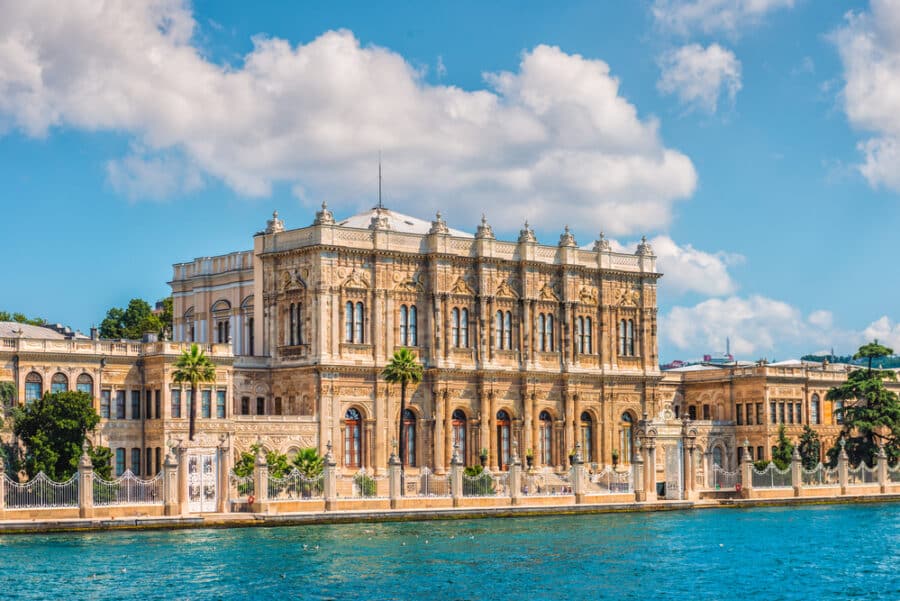
We got so confused at all of the Turkey toll information we found, this saved us!!